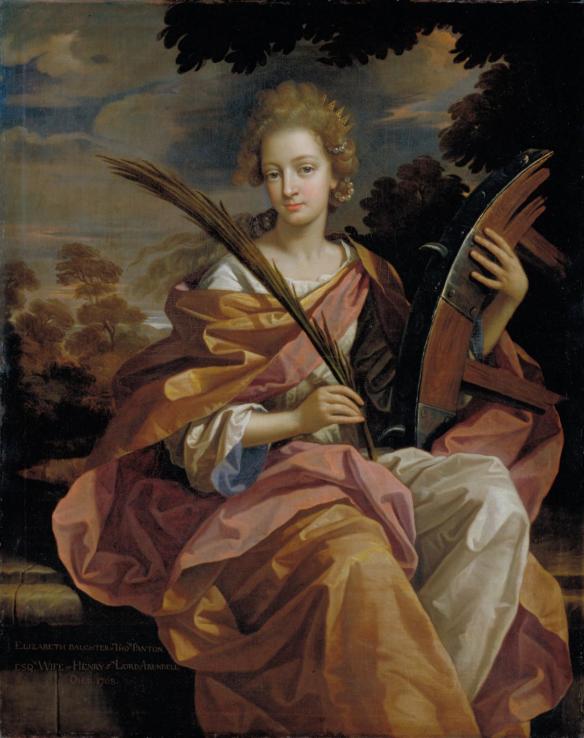
Lady Anne Arundell [née Herbert] was a daughter of Sir William Herbert, 2nd Marquess of Powis and his wife, Mary Preston.[1]
Family
By her father, Anne was a descendant of the Herbert branch of Powis Castle that began with the second son of Sir William, 1st Earl of Pembroke and his first wife, Lady Anne [née Parr]–Sir Edward Herbert (June 1544-1595). Lady Anne was known for being the sister of Queen Katherine Parr, the 6th and surviving wife of King Henry VIII. Edward was father to the 1st Baron Powis. Lady Anne’s Mother, Mary, was the eldest daughter and co-heiress of Sir Thomas, 3rd and last Baronet of Furness, and his wife, Mary Molyneux. The Baronet Furness had been a priest, but upon the death of his elder brother, he left the priesthood behind and inherited the Preston estates. He married the daughter of Caryll, Viscount Molyneux and the couple had three children. His heir, Francis, died young and with him the title went extinct. Mary, at that time, became a co-heiress with her sister Anne who married Hugh, 2nd Lord Clifford of Chudleigh. Mary would marry, the then titled, Viscount Montgomery, William Herbert, around 1695. The title of Marquess of Powis would be granted to her husband later on.

Old Wardour Castle: the engraving by S. & N. Buck, 1735.
Marriage
A contract for the marriage of Lady Anne Herbert and Henry Arundell, 6th Baron Arundell of Wardour was signed on 18 January 1728/29. The 6th Baron was the son of Henry, 5th Baron Arundell of Wardour and his wife, Elizabeth Panton (d.1700).

Lady Elizabeth Arundell by Benedetto Gennari 1633–1715, Oil paint on canvas, Tate Gallery.
Elizabeth Panton was the eldest daughter of Colonel Thomas Panton, a member of Charles II’s life-guards and foot-guards. Panton’s success at gambling enabled him to buy property in Herefordshire and London’s west end, where he built what is now Panton Street. In July 1681 Elizabeth, with her mother and brother, left England, claiming health reasons but in actuality to escape the persecution they faced as Roman Catholics. The exiled Catholic court of James II at Saint-Germain-en-Laye in France became a natural focal point for English papists abroad. Gennari followed the Stuart court into exile in 1689, and his notebook records that this was the first work he produced from there.Anne was the second wife of Lord Arundell. (Tate)
Henry, the 6th Baron, had previously been married to Elizabeth Everard by whom he had issue. His heir was his son, also named Henry.
After her marriage, Lady Anne Herbert was styled as Lady Arundell of Wardour on 18 January 1728/29. From 18 January 1728/29, her married name became Arundell.[1]

Coat of Arms of the Barons Arundell of Wardour (1560-1944) (European Heraldry)
Lady Arundell died on 2 October 1757 at Salisbury, Wiltshire, England, without issue. She was buried on 5 October 1757 at Tisbury, Wiltshire, England. Her last will was dated from 17 May 1757 to 27 August 1757. Her will was proven (by probate) on 2 November 1757.[1]
Sources
- G.E. Cokayne; with Vicary Gibbs, H.A. Doubleday, Geoffrey H. White, Duncan Warrand and Lord Howard de Walden, editors, The Complete Peerage of England, Scotland, Ireland, Great Britain and the United Kingdom, Extant, Extinct or Dormant, new ed., 13 volumes in 14 (1910-1959; reprint in 6 volumes, Gloucester, U.K.: Alan Sutton Publishing, 2000), volume I, page 266. [The Peerage]
- Tate Art Gallery. Online.

